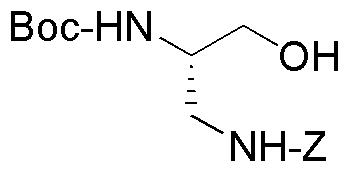Na-Boc-Nb-Z-L-2,3-diaminopropan-1-ol is widely utilized in research focused on:
- Peptide Synthesis: This compound serves as a valuable building block in the synthesis of peptides, enabling researchers to create complex structures for drug development and therapeutic applications.
- Drug Development: Its unique properties make it an ideal candidate for developing new pharmaceuticals, particularly in the field of targeted therapies where precision is crucial.
- Bioconjugation: The compound can be used in bioconjugation processes, allowing for the attachment of biomolecules to therapeutic agents, enhancing their effectiveness in medical treatments.
- Research in Neuroscience: It plays a role in studying neurological pathways, providing insights into potential treatments for neurodegenerative diseases.
- Material Science: This chemical is also explored in the development of new materials, particularly those that require specific functional groups for enhanced performance in various applications.
General Information
Properties
Safety and Regulations
Applications
Na-Boc-Nb-Z-L-2,3-diaminopropan-1-ol is widely utilized in research focused on:
- Peptide Synthesis: This compound serves as a valuable building block in the synthesis of peptides, enabling researchers to create complex structures for drug development and therapeutic applications.
- Drug Development: Its unique properties make it an ideal candidate for developing new pharmaceuticals, particularly in the field of targeted therapies where precision is crucial.
- Bioconjugation: The compound can be used in bioconjugation processes, allowing for the attachment of biomolecules to therapeutic agents, enhancing their effectiveness in medical treatments.
- Research in Neuroscience: It plays a role in studying neurological pathways, providing insights into potential treatments for neurodegenerative diseases.
- Material Science: This chemical is also explored in the development of new materials, particularly those that require specific functional groups for enhanced performance in various applications.
Documents
Safety Data Sheets (SDS)
The SDS provides comprehensive safety information on handling, storage, and disposal of the product.
Product Specification (PS)
The PS provides a comprehensive breakdown of the product’s properties, including chemical composition, physical state, purity, and storage requirements. It also details acceptable quality ranges and the product's intended applications.
Certificates of Analysis (COA)
Search for Certificates of Analysis (COA) by entering the products Lot Number. Lot and Batch Numbers can be found on a product’s label following the words ‘Lot’ or ‘Batch’.
Numéro de catalogue
Numéro de lot/série
Certificates Of Origin (COO)
This COO confirms the country where the product was manufactured, and also details the materials and components used in it and whether it is derived from natural, synthetic, or other specific sources. This certificate may be required for customs, trade, and regulatory compliance.
Numéro de catalogue
Numéro de lot/série
Safety Data Sheets (SDS)
The SDS provides comprehensive safety information on handling, storage, and disposal of the product.
DownloadProduct Specification (PS)
The PS provides a comprehensive breakdown of the product’s properties, including chemical composition, physical state, purity, and storage requirements. It also details acceptable quality ranges and the product's intended applications.
DownloadCertificates of Analysis (COA)
Search for Certificates of Analysis (COA) by entering the products Lot Number. Lot and Batch Numbers can be found on a product’s label following the words ‘Lot’ or ‘Batch’.
Numéro de catalogue
Numéro de lot/série
Certificates Of Origin (COO)
This COO confirms the country where the product was manufactured, and also details the materials and components used in it and whether it is derived from natural, synthetic, or other specific sources. This certificate may be required for customs, trade, and regulatory compliance.


